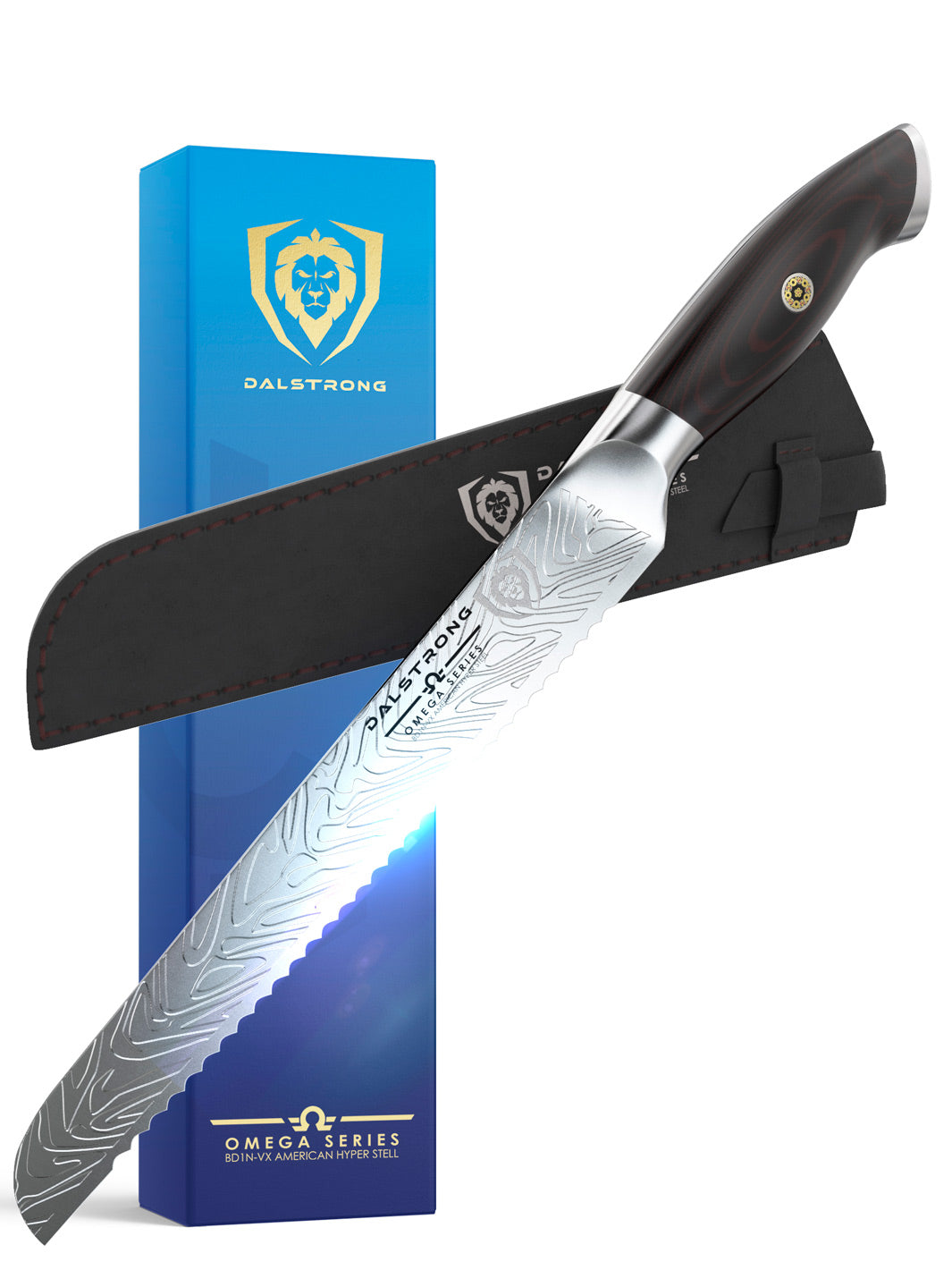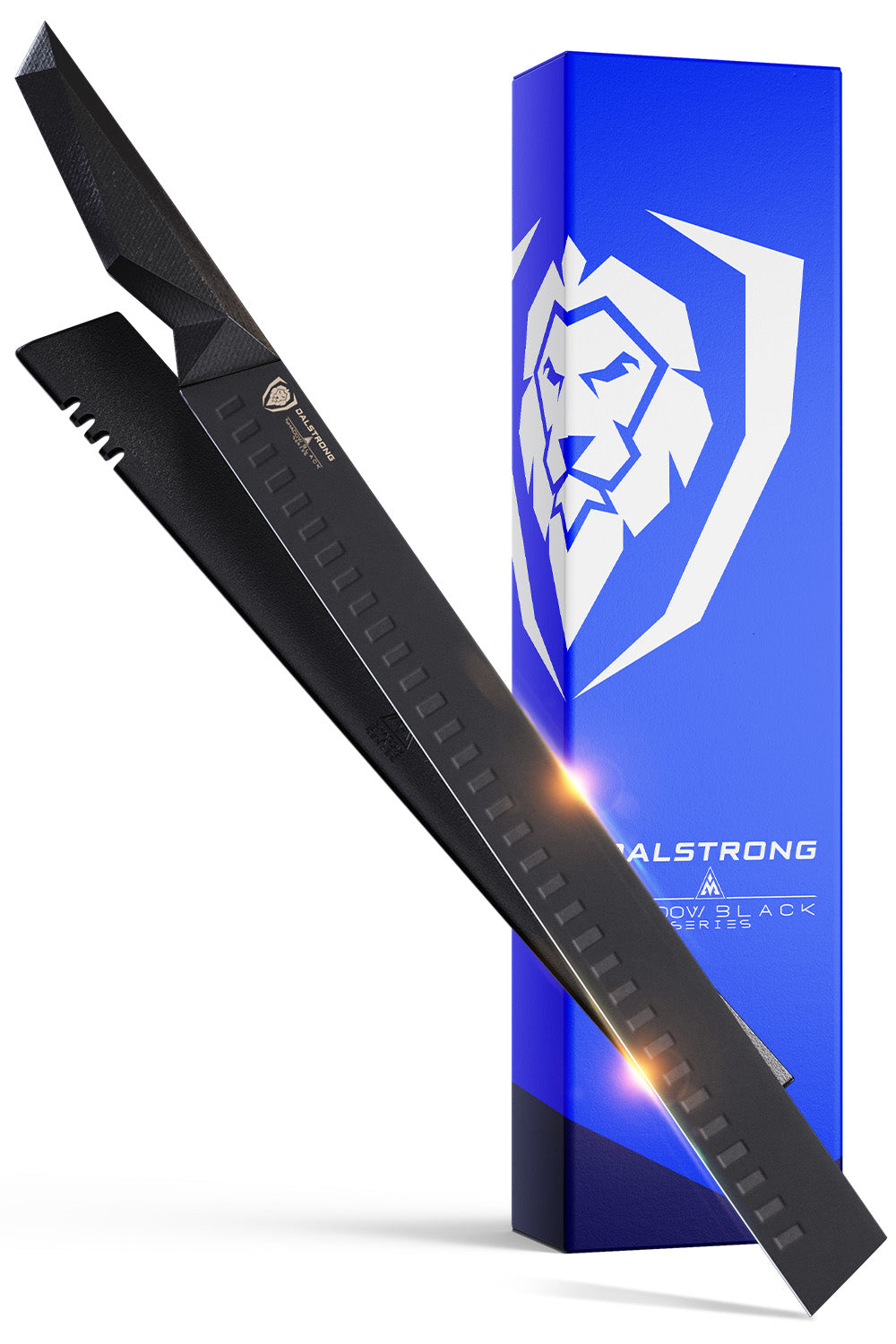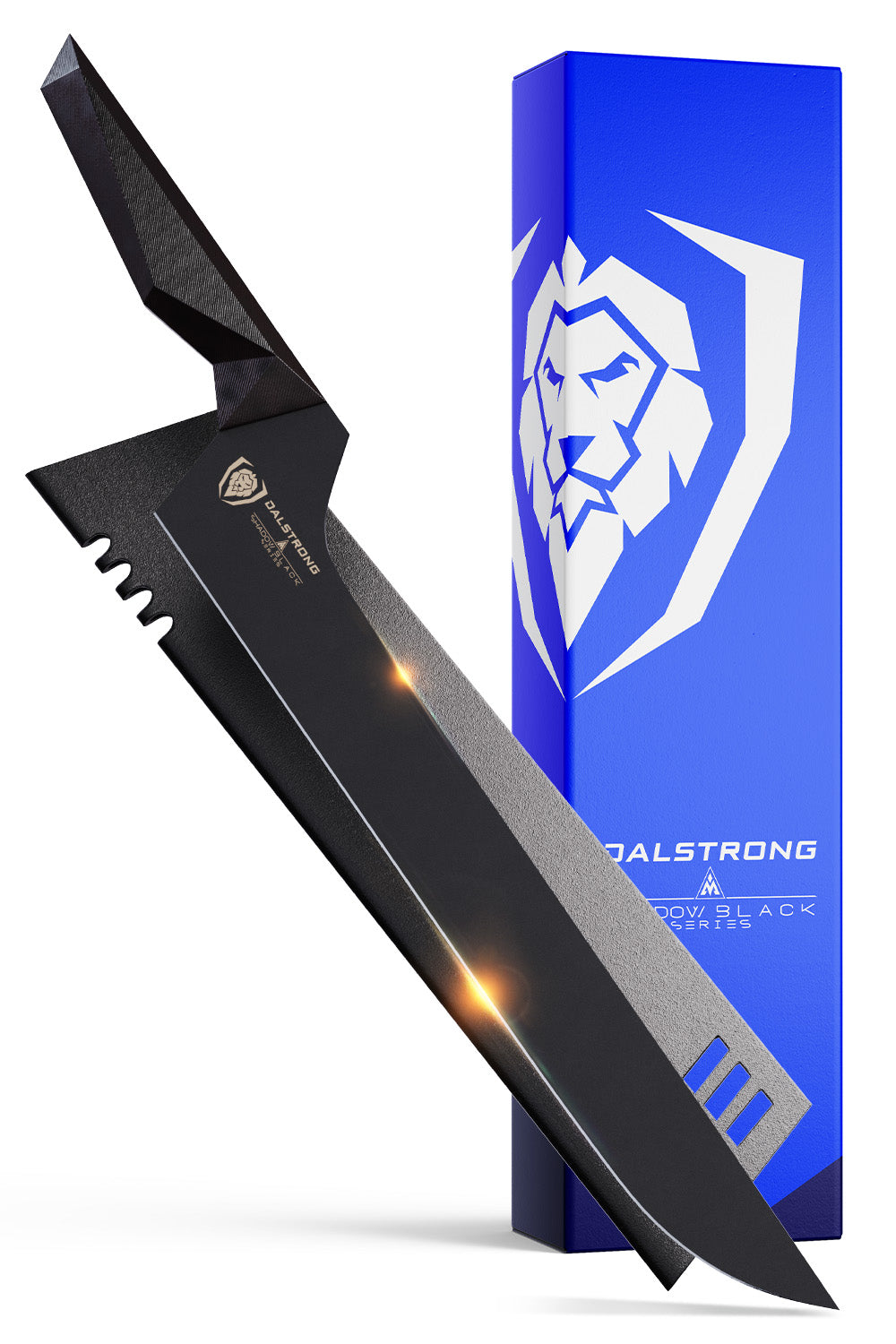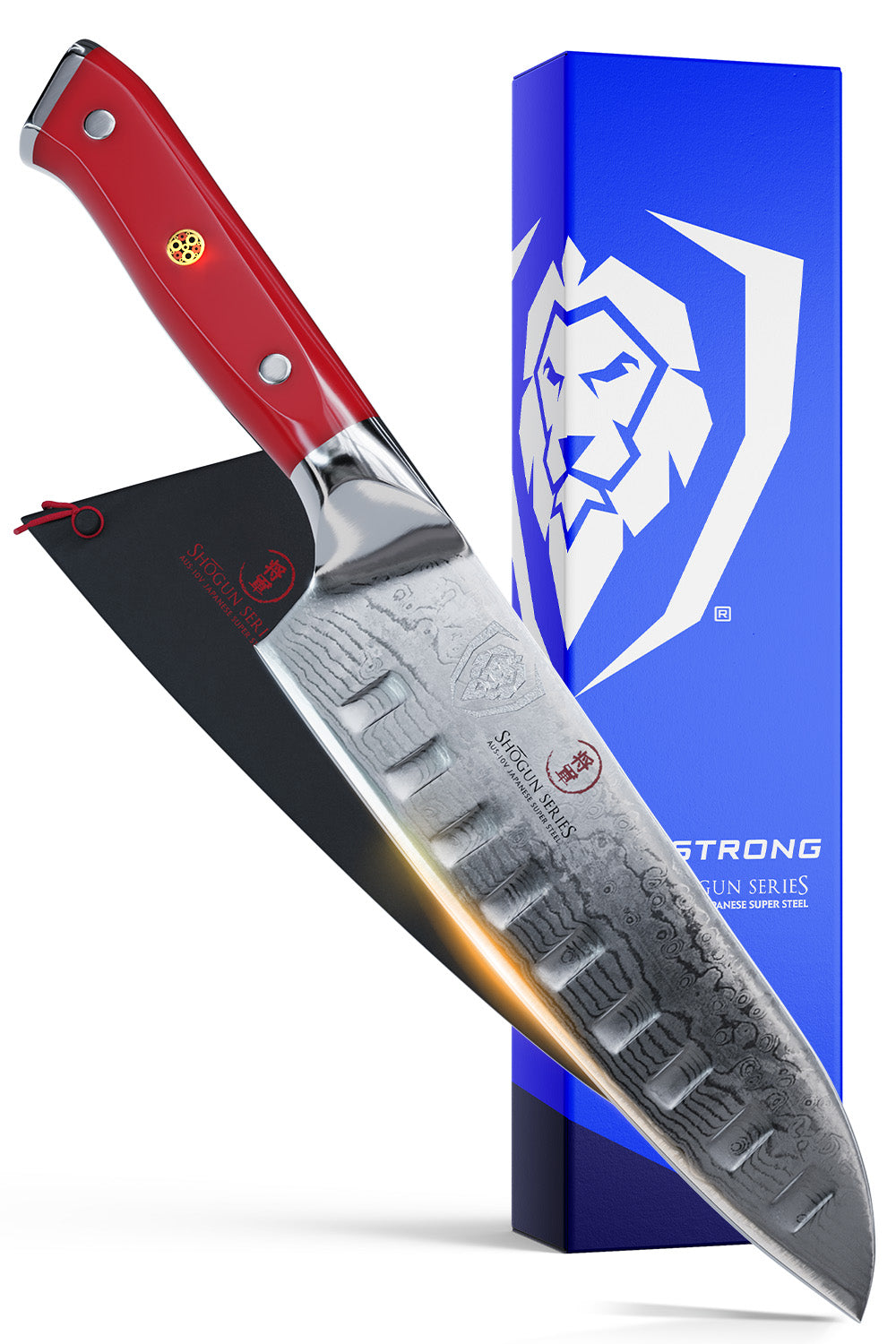
10" Frying Pan & SkilletETERNA Non-Stick | Oberon Series | Dalstrong
Skillets are one of the most versatile pieces of cookware you can own; and yet, we know very little about what makes a skillet, a skillet. It’s actually unfair that we use the term loosely for something that brings so much joy to the kitchen.
1. What Is a Skillet?
A skillet is a type of cooking pan with a round shape, a flat bottom and sloping side walls. It can be used for shallow frying, sautéing vegetables, cooking eggs or pancakes; or browning meats or fish at high temperatures (among many other things).
Today, the term “skillet” is often used to talk about different types of cookware with similar characteristics. To avoid confusion, let’s check the specifications that make a skillet pan different from a frying pan, a sauté pan, nonstick frying pans or any other cooking pan.
Characteristics of a skillet
- Skillets have a wide, flat bottom to be in direct contact with the heat source, thus distributing and retaining heat optimally. This is especially true for skillets made of cast iron or multilayer stainless steel and aluminum.
- Skillets are characterized by their sloped walls, a feature that’s not shared with sauté pans, for example.
- Skillets usually feature a long handle that makes them ideal for holding, shaking, tossing, turning and maneuvering the pan and the ingredients.
- Skillets can be made of cast iron, stainless steel or other materials such as copper, ceramic, aluminum, carbon steel, enameled or non-stick coatings.
- Skillets are convenient for preparing recipes that require quick grilling over high heat, and for browning meats or cooking foods that need to be constantly turned or stirred with a spatula.
- They come in various sizes and capacities. The most popular sizes are the 8-inch, 10-inch and 12-inch skillets.
 The Avalon Series 9” Frying Pan and Skillet
The Avalon Series 9” Frying Pan and Skillet
2. Types Of Skillets
Skillets are classified into several types according to the material from which they are made, each with different qualities and requirements.
Cast iron skillet
A cast iron skillet is a star in kitchens around the world. They are made of an alloy of iron and carbon, they heat up evenly and retain heat very well. They are also resistant to the highest temperatures.
Cast iron skillets are perfect for grilling meats, shallow frying chicken to a crispy golden brown, or baking cornbread, for example. However, this material can’t handle acidic foods (like tomatoes) in large amounts and can sometimes alter the flavor of foods.
Cast iron pans in general tend to rust and they need to be seasoned before the first use.
Enameled cast iron skillet
These skillets are made of cast iron and coated with enamel (glass particles fused together with intense heat). This coating creates a non-porous finish, preventing iron from leaching into the food.
This type of pan conducts heat very well, you can cook almost everything in them! There is no need to season them, but seasoned cast iron still offers better non-stick qualities.
Aluminum skillet
Aluminum skillets are a popular, affordable choice. Aluminum is lightweight, and these skillets can withstand and conduct heat well.
This material is strong and skillets will not warp at high temperatures, but they do get scratched quite easily. They are ideal for frying and sautéing, but low quality aluminum skillets can react to alkaline and acidic foods.
It is recommended that aluminum skillets have additional stainless steel (see recommendations later in this article).
Copper skillet
Copper skillets heat up very quickly, but also lose heat quickly. They are not very resistant to high temperatures, but their excellent heat conductivity makes them good for sautéing, preparing sauces, jams and cooking delicate foods such as fish and seafood.
Copper is a very dense metal so these skillets are sturdy and durable, but also very expensive. The best copper skillets are coated with stainless steel to provide non-stick properties.
As copper tends to oxidize and turn green, it requires regular, special maintenance.
Carbon steel skillet
Carbon steel skillets are very similar to cast iron skillets. Both must be seasoned to perform at their best. They are oven safe, can go from stovetop to oven without a problem and are extremely durable. However, carbon steel skillets are lighter and smoother. Also, perfectly seasoned carbon steel pans have better non-stick properties than cast iron pans.
Stainless steel skillet
Lightweight and durable. You can cook anything in them: stir-fries, vegetables, sauces and meats. A stainless steel pan does not react with food. They heat well, quickly and evenly.
A stainless steel skillet does not need special non-stick treatment to make it suitable for use, although it does need a little oil to cook the food and prevent it from sticking. Stainless steel pans are suitable for all types of stoves, including induction.
Some of these skillets have aluminum core and/or non-stick coating.
Non-stick skillet
A non-stick skillet features a nonstick polymer. It is ideal for cooking delicate foods that require slow or moderate heat and very little oil. On the downside, nonstick frying pans can’t withstand high temperatures as well as others, and can be easily scratched by metal utensils.
Ceramic skillet
Ceramic skillets are another type of non-stick cookware. They are coated with silica gel. They are also lightweight and should not be used with metal utensils so as not to damage their coating. They are prone to chipping. Aesthetically speaking, one of the most beautiful materials on the market.
Hard anodized aluminum skillet
Hard anodized skillets have undergone an anodizing treatment to create a very hard outer layer and eliminate their porosity; also coated with high quality non-stick material. Hard Anodized aluminum is heavier and more resistant, can withstand high temperatures without being damaged and does not scratch when used with metal utensils. They are more expensive than other non-stick skillets.
3. Skillets Vs. Sauté Pans: The Basic Differences
The difference between a skillet and a saute pan is a bit blurry and therefore, prone to confusion. But once you understand why they are different, you will find the ideal use for each one in your kitchen.
SHAPE
The most important and evident difference between the two is the shape. Actually, this is the one difference that determines all of the other small differences. A sauté pan has a wide, flat bottom and higher walls. A skillet has angled walls and the base is usually a little smaller.
CAPACITY
Precisely because a skillet’s base is a bit smaller than a sauté pan, it can accommodate around 30% fewer ingredients than the former; even when they display the same diameter.
WEIGHT
Skillets are lightweight and perfect for stirring, for example, vegetables or small pieces of meat. Sauté pans tend to be heavier and not so easy to move around.
USES
Because of the weight difference, some say that ironically, skillets are better suited for sauteing than actual sauté pans. The light weight and the angled walls allow for the perfect “flip maneuver”, which by the way, is the best way to redistribute food and ensure even cooking.
On the other hand, sauté pans are better for searing meat or reducing a sauce. Skillets are not the best option for evaporating liquids, while sauteing pans are great for the job.
4. When To Use A Skillet?
- To cook perfectly browned meat and fish
- To sear pieces of meat, poultry, lamb chops, skewers, etc.
- As a grill for vegetables, bread, beef, sausages, chicken or others.
- To bake pieces of veal, lamb, pork or poultry.
- To bake cornbread, deep dish pizza, tortillas, frittatas, quiches, pies, cookies or desserts.
- To cook directly over the coals (cast iron skillet)
- To brown or caramelize vegetables.
- Sauté dishes.
- To fry eggs.
- Recipes au gratin such as lasagne or vegetables.
- Some skillets can be used for deep frying (although some recommend a deeper pot)
- Other uses: In addition to the endless number of culinary delights you can prepare with a skillet, you can also use it to serve food directly from the fire to the table (of course, using a trivet to protect the surface from the heat); or to defrost meat, fish, vegetables or fruit.
5. What To Look For When Buying A Skillet Pan
You may be thinking 'Come on... How hard can it be? All pans with a lid are pretty much the same’, in reality, the many options available make it easy to end up making the wrong decision.
There are many factors at play: sizes, materials, design, specifications, prices, personal preference, even the style and storage space in your kitchen. And they all matter equally.
The first thing to establish is what you want the skillet for. Are you looking for a workhorse? Or just something to make omelets for breakfast? What kind of stove will you be cooking on? Do you need a skillet that can go in the oven? How many people do you usually cook for?
Basic things to consider:
Material
As we described in our previous point, each material brings their own advantages and disadvantages. Cast iron is versatile and will last a lifetime; but they’re heavy and require special treatment. Stainless steel is lighter and equally durable, you only need to watch out for sticky recipes. Non-stick, on the other hand, requires special care and cannot go in the oven. Aluminum is a great option but only if you can afford quality.
Diameter
Skillets come in varied sizes. A 12-inch skillet is a good, standard size for most cooking tasks. But whether you plan to buy a single skillet or perhaps a skillet set, it's important to consider what size is appropriate for your intended use and storage space. Important note: because skillets have slanted sides, you must measure the bottom of the pan to understand the real cooking surface available.
Weight
A skillet that is too heavy is solid and stable, but it may not be practical. A skillet that is too light may be unstable. It's a personal choice, but make sure it’s comfortable for you to maneuver the skillet you choose.
Handle
Preferably, the handle in your skillet should meet some requirements: high-quality and coated with a heat-resistant material for safety; ergonomic design, well riveted to the skillet; and not too short, so you can maneuver the skillet properly.
Lid
I think pans with a lid have a clear advantage over those without a lid. A lid will retain heat, even after cooking and will prevent accidents too.
6. How To Care And Maintain Your Skillet Pan
If it’s a stainless steel skillet pan
Good news! Stainless steel is the easiest of all materials, it’s so durable and resistant, that you can just relax. We recommend hand-washing them with warm water, dish soap and a sponge. Dry thoroughly, every time!
Try to wash them immediately after every use and avoid letting leftovers dry and stick to the skillet surface. Learn the details to season and maintain your stainless steel cookware here.
If it’s a cast-iron skillet
Cast-iron skillets require a bit more attention. Starting with the fact that they need to be seasoned to prevent rusting and to make them non-stick. Seasoning cast iron is usually done by adding a layer of oil and heating the skillet in the oven to a medium high temperature.
Important: Cast iron cookware cannot go in the dishwasher, ever. Also, avoid soaking and dish soap, or the skillet will need to be reseasoned. A detailed guide to cleaning cast iron can be found here.
If it’s a copper skillet
There are certain foods you should avoid cooking in a copper skillet, like tomato sauce. Never use abrasive materials for cleaning your copper skillet, and never put it in the dishwasher, no matter how tempting.
You can polish copper cookware every six months or so to keep tarnish at bay. As is the case for most pots, pans and skillets: never heat a copper pan that is dry or empty. Read this In-Depth Guide to Copper Pans.
If it’s an aluminum skillet
Same: avoid acidic and salty foods and never clean with steel wool (you could damage the cooking surface). Aluminum tends to discolor over time, you can fix this with warm water and white vinegar, lemon juice or tartar. Aluminum is not as sturdy as cast iron or copper, so handle carefully.
If it’s a non-stick skillet
Non-stick skillets offer many advantages, but in return, you need to take good care of them. Never use metal or abrasive tools. Never, ever put them in the dishwasher (no matter what the manufacturer says). Wash them with a soft sponge and dry immediately. Avoid cooking sprays.
7. Best Dalstrong Skillets
1. 10" Frying Pan & Skillet | ETERNA Non-Stick | Oberon Series
This noble skillet from the Oberon Series will become that humble friend that’s always there when you need them. Highly functional, super durable and medium weight: a high quality product made in the US to endure from the most challenging recipe to the most mundane cooking tasks.
PROS:
- 3-ply aluminum cladding.
- Perfect heat conductivity (it heats up super quick and evenly).
- Additional layers of non-reactive stainless steel.
- State-of-the-art non-stick technology.
- Extra thick tempered glass lid.
- Perfectly angled handle for a comfortable grip.
CONS:
- Some recipes may require a larger skillet.
- Some people prefer a round handle instead of a square one.
2. 9" Skillet Frying Pan | Hammered Finish - Black | The Avalon Series
Luxury meets performance. The black design of this skillet is just stunning. Weather is a delicate or a thick dish; whether you’re searing, browning, sautéing, frying or boiling; there’s nothing you cannot do with this -rather smaller- skillet from the Avalon Series.
PROS:
- 5-ply Copper Foundation (best of its kind).
- It preserves the best qualities of the food you’re cooking, like taste and color.
- Compatible with all stovetops.
- Oven safe! You can also use it for baking.
- Non-toxic, non-hypoallergenic.
- Eye-catching exterior design.
- It comes with a scratch-free silk carrying bag.
CONS:
- Because of its solid construction and materials, this skillet can feel heavy for some.
- If non-stick properties are really important to you, consider getting a non-stick skillet instead.
3. 12" Frying Pan & Skillet | Oberon Series
This is just not any aluminum cookware. 3-ply aluminum core, layers of nonreactive 18/10 stainless steel, plus additional layers of satin & nylon polish: it all speaks for itself. If you’re working on a recipe that calls for very precise temperature changes, this is the one for you.
PROS:
- You can use it to transition any preparation from the stovetop to the oven.
- Engraved side-handle for better weight distribution.
- Built to last a lifetime with aluminum, secured rivets.
- Also: Freezer, dishwasher, and refrigerator safe
- The lid has a vented hole for pressure release.
CONS:
- If you cook in small quantities or just for yourself, you may not need a 12” skillet.
- Again, if you’re a non-stick fan, it’s best if you go for nonstick pans.
4. 10" Frying Pan & Skillet | Oberon Series
The ultimate silver skillet that also doubles as a frying pan with a lid. An omelet for breakfast, a healthy stir fried vegetable dinner or indulging deep fried chicken pieces, you name it. This skillet will be there for you on any occasion.
PROS:
- 3-Ply Aluminum-Core with fused layers of 18/10 stainless steel.
- You can use it on induction, gas and electric stoves.
- It doesn’t sound like much but I will count it as a pro: The packaging is amazing. It almost doesn’t feel right to throw it away.
- Easy to clean.
- The size is ideal for almost any meal that comes to mind.
CONS:
- The size is pretty standard, but some still claim a 12” skillet is the safest bet. If you get a skillet set, you’ll get the different sizes available.
- If food happens to stick to this pan, you will have to use some of these methods to clean it (none of which is complicated, by the way).
5. 12" Frying Pan & Skillet | Hammered Finish Black | Avalon Series
A truly stunning piece of cookware to honor your love for cooking. The walls are so high it looks like a wok.
PROS:
- This one heats five times better than iron and twenty times better than stainless steel.
- Ergonomic side handles for easy pouring.
- The exterior has been designed to provide more stability and grip on electric ranges, induction cooktops and gas stoves.
- Built to endure and resist: it will never dent or warp under prolonged heat.
- Stainless steel lid with a perfect fit.
- The lid knob displaying the Dalstrong logo is a nice detail.
CONS:
- Slightly more expensive than the average skillet.
- Heavy gauge, which is actually a good thing when it comes to cookware, but maybe that’s not your thing.














